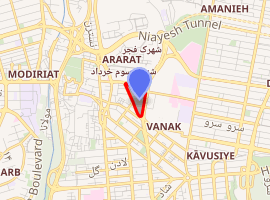Ararat Stadium
Ararat Stadium (Armenian: Արարատ մարզադաշտ; Persian: ورزشگاه آرارات) is a football stadium with 10,000 seats built in 1971 and located in the Ararat Sports Complex in the Vanak neighbourhood of Tehran, Iran. It is named after Mount Ararat, the highest mountain of the Armenian Highlands in what is now Turkey. The complex is owned by the Armenian Cultural Ararat Organization founded in 1944, one of the largest associations of Iranian Armenians. The stadium is used by Ararat Tehran, who play in the Tehran Provincial League. It has also been used by the Iran women's national football team for their home matches.

| |
| Full name | Ararat Stadium |
|---|---|
| Location | Vanak, Tehran, Iran |
| Owner | Ararat Tehran |
| Operator | Ararat Tehran |
| Capacity | 15,000 seated |
| Surface | Grass |
| Tenants | |
| Ararat Tehran Iran women's national football team | |
Location and architecture
The complex covers an area of 74,000 square meters in form of a triangle enclosed by Ararat Street, Rashid Yasemi Street and Kordestan Expressway. The entrance is in the northern part of Ararat Street. The football stadium of FC Ararat Tehran with 10,000 seats was built in 1971 after plans by architect Rostom Voskanian (1932–2013). Near the stadium in the southeastern part of the complex, there is the Holy Cross Chapel (Surp Khatch) completed in 1987 by the same architect, a small concrete building with block-like crosses, built in part in memory of the Iranian Armenian soldiers who lost their lives in the Iran–Iraq War. The Ararat Sports Complex has also two swimming pools, indoor basketball courts, billiard tables, a rock climbing facility, badminton courts, tennis fields, and a sports museum.[1][2]
Cultural life
Access to most events in the stadium is restricted to Christians, so Armenians are usually among themselves. As long as no Muslims are present, Christian males and females are allowed to practice or watch together, and women are not required to wear headscarves. According to participants, the Sports Complex has its own Armenian atmosphere very different from the Muslim world outside. Even the dominant language spoken by participants (in 2017) is Armenian, and Persian is reportedly rarely spoken.[1]
However, there are inter-ethnic activities, e.g. football matches, where general Islamic regulations have to be followed. In September 2016, the Pan-Armenian Games were held in the Ararat Complex of Tehran with about 800 Armenian athletes from Iran, Armenia and Georgia participating. At the opening ceremony, Ali Younesi, Hassan Rouhani’s Aide in Religious Minorities’ Affairs, was present.[3][4]
Famous athletes
The most important sports club playing in Ararat Stadium is FC Ararat Tehran, a football club that existed from 1944 to 2009 and was dissolved because it was bankrupt. However, it was refounded in 2014, and in 2015 it was playing in the Tehran Province league. Though it never played a dominant role in Iranian football, it produced at least two important football players: One was Andranik Eskandarian, who later played for Taj (now Esteghlal F.C.). After the Islamic Revolution, it was Andranik Teymourian who started his career at Ararat Stadium, later played for the Bolton Wanderers F.C. in the English Premier League, then for Esteghlal F.C. and Tractor Sazi F.C. and in 2015 was appointed new captain of the Iran national football team.[2]
References
- Holy Cross Chapel – An unexpected icon, this church brings Armenian-Iranians together. Brownbook – An Urban Guide to the Middle East, issue 62 — The Brutalist Architecture in Tehran. Plus Memar Magazine Archives. March – April 2017.
- Asher Kohn: Towards an Armenian-Iranian Modern: Tehran Church Architecture & Post-Revolutionary Soccer Culture. Ajam Media Collective, 1 December 2012.
- Pan-Armenian Games Kick Off in Tehran. Iran Front Page (IFP), 14 September 2016.
- Tehran Playing Host to Pan-Armenian Games. Archived 2017-12-22 at the Wayback Machine Iran Front Page (IFP), 16 September 2016.